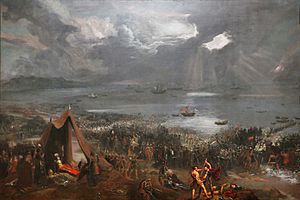Battle of Clontarf facts for kids
Quick facts for kids Battle of Clontarf |
|||||||
|---|---|---|---|---|---|---|---|
|
Battle of Clontarf, oil on canvas painting by Hugh Frazer, 1826 |
|||||||
|
|||||||
| Belligerents | |||||||
| Forces of the High King of Ireland | Kingdom of Dublin Kingdom of Leinster Vikings of Orkney and Mann |
||||||
| Commanders and leaders | |||||||
| Brian Boru † Murchad mac Briain † |
Sigtrygg Silkbeard Máel Mórda † Sigurd the Stout † Brodir † |
||||||
| Strength | |||||||
| 7,000 men | ~6,600 men | ||||||
| Casualties and losses | |||||||
| 1,600–4,000 dead | ~6,000 dead | ||||||
The Battle of Clontarf (Irish: Cath Chluain Tarbh) was a very important battle fought on April 23, 1014. It happened near the River Tolka, close to the town of Clontarf in Dublin, Ireland. This battle was between the forces of Brian Boru, who was the High King of Ireland, and a group of Vikings and some Irish allies.
The other side included the King of Dublin, Sigtrygg Silkbeard, and the King of Leinster, Máel Mórda mac Murchada. They also had help from Vikings from places like Orkney and the Isle of Man, led by Sigurd the Stout and Brodir. The battle lasted all day, from sunrise until sunset. In the end, Brian Boru's army won a big victory.
Contents
What Was the Battle of Clontarf?
The Battle of Clontarf was a major conflict in early Irish history. It was a clash between the most powerful ruler in Ireland, Brian Boru, and a group of his enemies. These enemies were a mix of Irish kings and Viking leaders who had settled in Ireland. The battle decided who would have power in Ireland.
Who Fought in the Battle?
On one side was Brian Boru, the High King of Ireland. He led a large army of Irish warriors. Brian was an old but very strong leader who wanted to unite Ireland.
On the other side was an alliance of different groups:
- The King of Dublin, Sigtrygg Silkbeard, who was a Viking ruler.
- The King of Leinster, Máel Mórda, an Irish king who was allied with the Vikings.
- Viking warriors from outside Ireland, like Sigurd from Orkney and Brodir from the Isle of Man.
Where Did It Happen?
The battle took place in Clontarf, which is now part of modern-day Dublin. At that time, Dublin was a small Viking town. The fighting spread from the coast near the River Tolka further inland.
The Day of the Battle
The battle began early in the morning on April 23, 1014. Thousands of soldiers from both sides fought fiercely. It was a very bloody and long battle. Estimates suggest that between 7,000 and 10,000 men were killed that day.
The Outcome of the Fight
Brian Boru's forces won the battle. They defeated the Viking and Leinster armies. However, the victory came at a great cost. Brian Boru himself was killed during the battle. His son, Murchad, and his grandson, Toirdelbach, also died.
On the other side, the Leinster king Máel Mórda was killed. The Viking leaders Sigurd and Brodir also lost their lives.
Why Was This Battle Important?
The Battle of Clontarf had a huge impact on Ireland.
- End of Viking Power: After this battle, the power of the Vikings in Ireland was greatly reduced. The Kingdom of Dublin became much weaker.
- Brian Boru's Legacy: Even though Brian Boru died, his victory was seen as a moment that freed Ireland from foreign rule. He became known as a national hero.
- Leadership in Ireland: With Brian Boru gone, there was no clear High King of Ireland for a long time. It took until the late 1100s for another undisputed High King to emerge.
For many years, especially when Ireland was under English rule, the Battle of Clontarf was seen as a symbol of Irish freedom. Today, historians look at the battle in a more detailed way. But it still remains a very famous and important event in Irish history.
Images for kids
See also
 In Spanish: Batalla de Clontarf para niños
In Spanish: Batalla de Clontarf para niños





